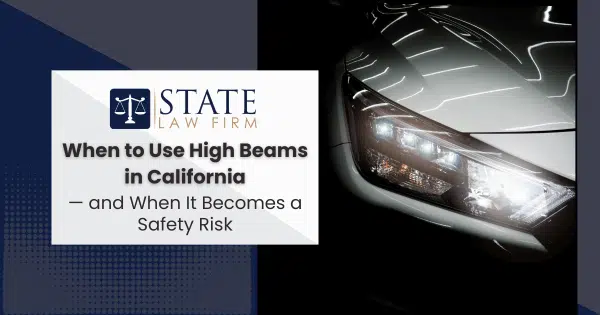Driving at night comes with its share of challenges—and California’s winding hills and sprawling rural landscapes only add to the stakes. High‑beam headlights can be an invaluable tool for enhancing visibility when roads are poorly lit. But used incorrectly, they can blind oncoming drivers, create unexpected glare, and turn a routine nighttime drive into a safety hazard.
At State Law Firm, our team of energetic, emerging trial attorneys knows that understanding when—and how—to use high beams isn’t just about lighting the road ahead; it’s about protecting yourself and others. We’re not just your advocates—we’re your guides, illuminating complex safety rules without sacrificing warmth or clarity.
For instance, did you know that vehicles with “good” headlight systems—those that balance brightness with glare control—have nearly 20% fewer nighttime crashes than those with poor lighting? This underscores why getting high-beam use right isn’t just good driving practice—it may save lives.
In the following sections, we’ll walk you through:
- Understanding High Beam Headlights: what they are, how they differ from low beams, and the technology behind them
- California’s Headlight Laws: when the law requires you to dim, as laid out in the vehicle code
- Ideal Conditions for High-Beam Use: where the extra reach helps—and where it doesn’t
- Situations to Avoid Using High Beams: including crowded streets, pedestrians, and urban glare zones
- How Misused High Beams Affect Others: from compromising pedestrian safety to disrupting fellow drivers
Curious about legal support instead? Suppose you’ve been injured in a bus crash in Fresno. In that case, you may benefit from working with a Fresno bus accident attorney—and if you’re ready to talk about your rights after a collision, don’t hesitate to request a free consultation with us.
Understanding High Beam Headlights: What You Need to Know
High beams, often called “brights,” are designed to project light much farther down the road than low beams—often up to 350–500 feet—and spread light more widely to illuminate road shoulders and surrounding areas. This extra visibility is crucial in spotting hazards like wildlife, stalled vehicles, or sharp turns on dark roads.
However, many drivers either underuse or misuse them. According to the Insurance Institute for Highway Safety, vehicles equipped with Good-rated headlights have nearly 20% fewer nighttime single-vehicle crashes than those with Poor ratings. That same study found that drivers often fail to use high beams even in pitch-dark rural areas, which can significantly reduce reaction time.
Why this matters for safety:
In our legal practice, we’ve handled injury claims where the other driver either blinded oncoming traffic by keeping their high beams on or failed to use them in areas where visibility was dangerously low. Both situations can be the difference between avoiding a crash and becoming part of one.
Pro Tip: Keep your headlights clean and properly aligned. A slight tilt can cause glare for oncoming drivers or reduce your field of vision, and dirty lenses can cut headlight performance by up to 40%.
California Laws Regarding Headlight Use: The Rules You Should Follow
California law is very clear about when high beams are permitted and when they must be dimmed. California Vehicle Code Section 24409 requires drivers to dim their high beams within 500 feet of oncoming traffic and 300 feet when following another vehicle.
Penalties for violating high beam laws include:
- A fine of up to $238
- One DMV point on your driving record can lead to higher insurance premiums and, in some cases, license suspension.
It’s also worth noting that flashing high beams to alert another driver—whether to warn them of police ahead or to let them know their lights are off—is not legal within these distances.
Real-world takeaway: We’ve seen police accident reports cite improper headlight use as a contributing factor to collisions. Following these rules isn’t just about avoiding a ticket—it’s about preventing harm.
Ideal Conditions for Using High Beams: Maximizing Visibility
When used correctly, high beams can double your sight distance compared to low beams. This gives you more time to react, particularly when driving at higher speeds.
Best scenarios for high beam use include:
- Rural highways with no street lighting and no other vehicles nearby
- Mountain roads at night where turns can hide obstacles
- Open interstates with long stretches of darkness and minimal traffic
- Areas where wildlife crossings are common, such as near forests or agricultural land
The California DMV advises using high beams whenever you are in a low-traffic, dark environment and visibility is otherwise limited. Our attorneys have reviewed crash reconstructions where high beam use could have provided an extra 200 feet of reaction time—often enough to avoid impact.
Pro Tip: Watch for reflective signs or animal eyes in the distance. Switching to high beams as soon as it’s safe can help you identify hazards earlier.
Situations Where High Beams Should Be AVOIDED: Ensuring Safety on the Road
Even in dark conditions, high beams aren’t always the right choice.
Avoid using high beams when:
- Driving in fog, heavy rain, or snow — Bright light scatters in these conditions, creating glare and reducing visibility (Federal Highway Administration).
- In well-lit urban areas, High beams can make it harder for your eyes to adjust between lit and dark areas.
- Approaching or following another vehicle within the legal distances — Even brief exposure to high beam glare can temporarily impair another driver’s vision.
From a legal standpoint, we’ve seen improper high beam use cited in accident reports as a form of negligence, particularly in pedestrian injury cases. In one urban collision we reviewed, the driver’s high beams made it harder to see a pedestrian stepping into a crosswalk—despite the street being well-lit.
The Impact of Improper High Beam Usage on Other Drivers and Pedestrians
Improper high beam use can do more than annoy other drivers—it can create real danger.
- Glare blindness: Research shows glare can impair vision for up to 5 seconds after exposure (IIHS).
- Pedestrian safety risks: The majority of pedestrian fatalities occur at night, often in poorly lit areas, and glare can make it harder for drivers to spot people in time to stop.
- Road-sharing etiquette: Misused high beams can cause other drivers to overcorrect, drift, or brake suddenly—leading to chain-reaction crashes.
Pro Tip: If you’re unsure whether your high beams could affect another driver or pedestrian, dim them. Courtesy on the road often translates into safety.
Why Choosing a State Law Firm Can Make a Difference
At State Law Firm, we’ve built our reputation not only on strong legal knowledge but also on real-world driving insight. We understand how seemingly minor details—like when to use high beams—can make or break a case involving driver negligence.
If you’ve been injured in a traffic crash, pedestrian accident, or e-scooter incident, you may benefit from working with a Stockton e-scooter accident attorney. You can also request a free consultation to learn about your legal options. We’re here to help you recover and guide you through every step of the legal process.
Frequently Asked Questions About High Beam Use in California
1. When should I turn on my headlights in California?
California law requires headlights to be on 30 minutes after sunset until 30 minutes before sunrise, and whenever visibility is less than 1,000 feet (California DMV). This includes fog, heavy rain, and snow. Remember, your headlights should always be on when windshield wipers are in continuous use.
2. Can I use LED high beams in California?
Yes, LED high beams are legal as long as they meet federal standards for brightness and beam pattern (NHTSA). However, like any high beam, they must be dimmed within 500 feet of oncoming traffic and 300 feet when following another vehicle.
3. Is it legal to flash high beams to alert other drivers?
No, California Vehicle Code Section 24409 prohibits flashing high beams at vehicles within the 500/300-foot limits, even if you are trying to warn another driver.
4. Should I use high beams in foggy conditions?
No. High beams in fog will reflect off water droplets, creating glare and reducing your ability to see. Instead, use low beams or fog lights for better visibility.
5. Can improper high beam use affect fault in an accident?
Yes. In personal injury cases, police accident reports and eyewitness testimony often cite improper high beam use as a contributing factor. At State Law Firm, we’ve handled cases where misuse of headlights was a key element in proving negligence.


